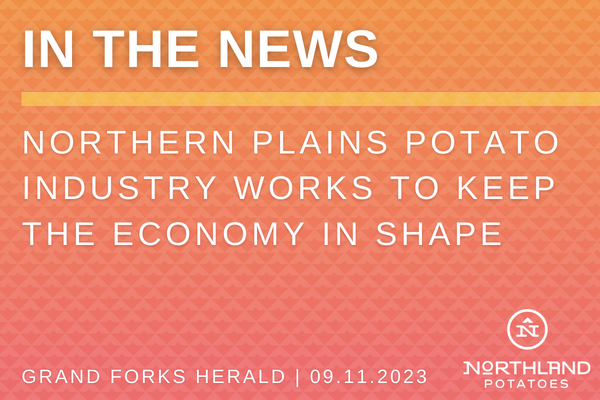Northern Plains potato production is valued at $500 million, employs 5,600 full-time equivalent workers and makes up 17% of the agriculture and food processing industry.

The potato trucks rumbling down the roads of North Dakota and western Minnesota during the September harvest season carry a commodity that contributes significantly to the health of the northern Plains economy.
The region’s potato production — the third largest in the United States — is valued at $500 million, employs 5,600 full-time equivalent workers and makes up 17% of the agriculture and food processing industry, according to Northland Potato Growers Association’s website.
Potatoes have long been a staple in northern Plains fields — in 1943, North Dakota farmers planted a record 191,000 acres — but the industry has greatly evolved and changed as technology, the advent of irrigation and improved varieties have resulted in the production of more hundredweight on fewer acres.
In 1984, for example, North Dakota farmers planted 136,000 acres of potatoes and Minnesota farmers planted 72,500.
North Dakota’s total potato production in 1984 was 20.6 million hundredweight and Minnesota’s was 13.8 million hundredweight.
Twenty-eight years later, in 2022, North Dakota farmers planted 74,000 acres, 47% fewer acres than they did in 1984, but total production in 2022 was 30 million hundredweight, which was 32% higher than in 1984.
Average per-acre yields in North Dakota in 2022 were 315 hundredweight, more than double the 155 hundredweight per acre farmers harvested in 1984.
In Minnesota, farmers planted 47,000 acres of potatoes in 2022, 25,200 fewer acres than in 1984, but both years produced about 20 million hundredweight.
Minnesota’s average 2022 yields of 430 hundredweight per acre were 63% higher than the average per-acre yield of 190 hundredweight in 1984.

Irrigation has been one of the major drivers of the production increase.
In general, about 60% of the potatoes in the northern Plains are grown under irrigation and used for processing, said Donavon Johnson, Northland Potato Growers Association president.
The drought years of 1987-1989, were the impetus for the move from growing dryland potatoes for processing to growing processing potatoes under irrigation, said Duane “Sarge” Preston, retired Extension potato specialist for North Dakota State University and the University of Minnesota.
The drought years reduced the quality of potatoes — they were small in size — and the quantity of the crop, which resulted in a shortage for the processors.
“We had to have a steady supply of potatoes, and we weren’t achieving this,” said Preston, who worked as U of M Extension and NDSU Extension potato specialist from 1977-2007.
A couple of farmers in the Red River Valley of North Dakota began growing potatoes under irrigation in the early 1990s, and then irrigated acreage was added near the North Dakota towns of Oakes and Karlsruhe and in Kidder County.
By 2018, there were a total of 28,300 acres of irrigated potatoes acres in North Dakota, according to NDSU.
Despite a cold, wet spring that delayed the start of spring planting, the 2023 irrigated potatoes are in good condition, said Andy Robinson, NDSU Extension and U of M Extension potato agronomist. Warm temperatures in late June and early July pushed potato development, and the majority of the harvest was expected to begin during the first full week in September, weather permitting.
Some irrigated potato fields had been harvested earlier in August, Robinson said on Aug. 24, 2023. Those potatoes were being hauled directly to the processing plant and were not put in storage.
It is difficult to put an exact number of yields, because the potato crop could put on as much as 40- to 50-hundredweight per acre between the third week in August and harvest, Robinson said.

“There ‘s still a lot of time for that to happen,” he said. “Right now, I’d say we’re probably around average.”
Johnson also declined to give an exact estimate of potato yields but said he expected it to be, overall, an “average year.”
North Dakota’s potato crop yielded an average of 325 hundredweight per acre between the years of 2019-2021 and Minnesota’s crop averaged 425 hundredweight during that same time period, according to the U.S. Department of Agriculture’s National Agricultural Statistics Service.
Besides the increase in irrigated acreage, another reason that fewer farmers now are producing more potatoes is that researchers have developed improved varieties of processing potatoes so farmers weren’t limited only to the Russet Burbank, Preston said.
For example, in 2012, the Dakota Russet, a variety developed by Asunta “Susie” Thompson was released. Often called “the grower’s potato,” the Dakota Russet is high yielding and doesn’t require as much fertilizer and water as some other varieties.
McDonald’s accepted the potato for use in its French fries in 2022. The Dakota Russet variety is one of eight McDonald’s has accepted in North America.
In addition to conducting research on increasing yields and improving varieties, NDSU Extension and U of M Extension researchers also work on weed and insect control in potatoes and on the efficacy of herbicides, Robinson said.
Many of the researchers, including Robinson, were on hand at Northland Potato Growers Association’s annual field held on Aug. 24, 2023. The field day gives growers an update on the Extension and USDA potato research projects and to ask them about what they perceive are future research needs.
The field day also included tours of potato fields of Oberg Farms near Hoople, North Dakota, and the Forest River Hutterite Colony near Forest River, North Dakota.
Matthew Maendel, Forest River Hutterite Colony crop farm manager, was optimistic about potato yields, he said during an interview with an Agweek reporter at the Aug. 24 field day.
The majority of the colony’s 1,000 acres of irrigated potatoes grown are for processing. Though the potatoes were planted this spring a few days later than average, they appeared to a good size as harvest approached, he said.
The Forest River Hutterite Colony planned to begin digging the potatoes during the last week of August or early September. During the harvest, from 15 to 30 semi-tractor trailer loads of Ranger Russet potatoes are hauled from fields near Forest River to J.R. Simplot in Grand Forks, where they will be processed into french fries.

“We’re feeding one of the main lines of the processing plant,” Maendel said on Aug. 24, 2023.
The Forest River Hutterite Colony also has 500 acres of Russet Burbank potatoes near McVille, North Dakota, which will be stored and later hauled to J.R. Simplot for processing. The harvest of those potatoes will begin during the second week of September, weather permitting.
While dry conditions didn’t affect the irrigated crop yields in 2023, it may have resulted in lower yields of red potatoes grown for the fresh market and also could result in some misshapen potatoes that are smaller than is typical, Robinson noted.
About 40% of the potatoes in North Dakota and Minnesota are grown for the fresh market.
Harvest of the northern Plains potato crop typically takes about a month, Robinson said.
If the weather is favorable for digging potatoes, the harvest is completed by Oct. 10.
“It doesn’t always happen, but it’s ideal because you know it’s going to get cold, the snow is going to happen,” Robinson said. “Bad things happen when it freezes with potatoes in the ground, we don’t want that.”

Johnson called fresh and processed potatoes’ contribution to the economy of the towns and cities of North Dakota and western Minnesota “huge.”
“It goes all the way from growing the product, certainly managing it, storing it,” he said. “In our area, we have processing plants.”
That means after the crop is harvested, the commodity has a ripple effect on the economy through the employment of wash plant workers, processing plant workers and transportation industry workers.
“Instead of shipping them off, we have a lot of workforce that gets involved in the processing of the potatoes throughout the year,” Johnson said.
From Grand Forks Herald. Read here.

